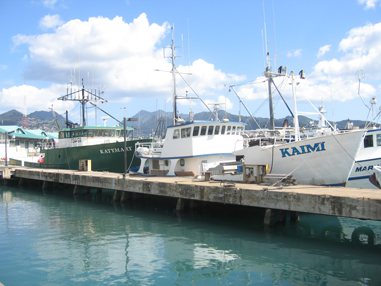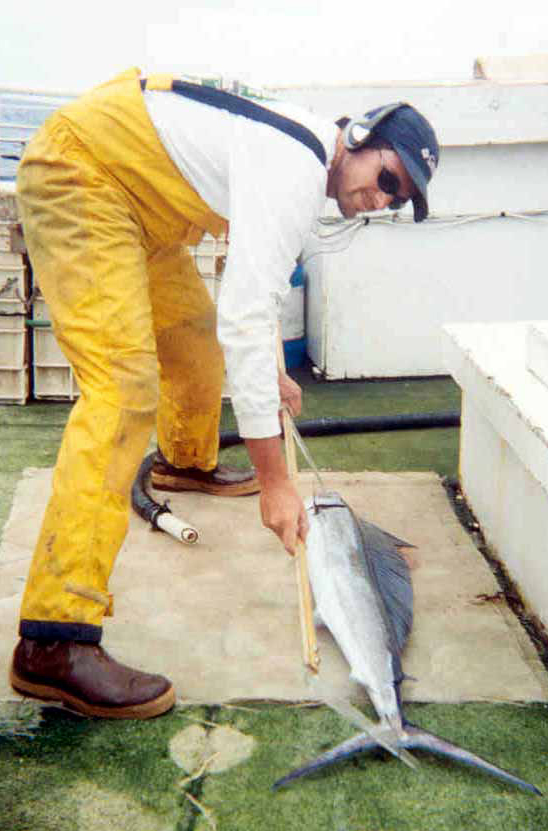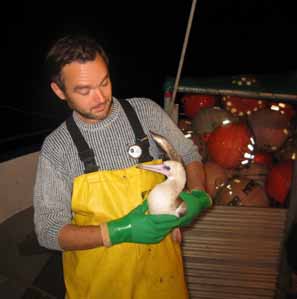Sustainability
HAWAII SEAFOOD SUSTAINABILITY STATEMENT
Hawaii Fisheries are Sustainable.
The people of Hawaii work together with unity of purpose to preserve fishing and protect fishery resources. The fishing sector collaborates with scientists and managers to reduce impacts and risk to protected species and to prevent fish populations from becoming overfished. Our fish are hook and line-caught, no gill nets, trawl nets or seine nets are used. We constantly strive to anticipate and exceed expectations for sustainable fishery management and to pioneer mitigations that reduce environmental impacts. We trace our seafood products directly to registered vessels that are accountable to government regulations and intensive monitoring by fishery observers.

The Hawaii longline fishery for tuna and swordfish produces sustainable seafood.
This fishery is sustainable because it meets the national and international requirements for:
1. Science-based, precautionary fishery management
2. Performance in managing fish populations for sustainability, and
3. Controlling fishery impacts on the ecosystem
The Hawaii fishery management system is exemplary.
This fishery operates under a model fishery management system. With every aspect of the fishery strictly regulated, closely monitored and tightly enforced, it is a model for sustainable pelagic fisheries worldwide. This management system is based on sound science and a transparent and inclusive fishery management process committed to sustainability.
The Hawaii longline fishery has a track record of precautionary conservation measures.
- 1991- First limited entry pelagic fishery in the U.S.
- 1991- First pelagic fishery in the U.S. to require daily logbook reporting.
- 1991- Longline fishing exclusionary zones set up around Hawaii.
- 1993- Fishery observers placed on vessels to monitor protected species impacts.
- 1994- First U.S. fishery to require vessel tracking using satellite technology.
- 2000- Shark finning was prohibited.
- 2004- Became the only Pacific fishery with a fleet limit on sea turtle interactions.
- 2004- Established the most extensive government fishery observer program of any Pacific longline fishery (100% of swordfish trips and more than 20% of tuna trips).

Key Elements of the Hawaii Longline Fisheries Management System.
- High compliance (94%) with the FAO Code of Conduct for Responsible Fisheries.
- Conformance with national, regional and international laws and rules.
- Management system can adapt to new information and/or changes in fish population status or environmental conditions through timely corrective actions.
- Strong science and research base.
- Effective monitoring, data availability and enforcement, including comprehensive observer program.
- Adherence to advice of the Scientific and Statistical Committee comprised of uniquely qualified scientists.
- Precautionary approach to address uncertainty.
- Transparent and inclusive stakeholder involvement in development of regulations.
- Fishing capacity is capped under the Hawaii longline vessel limited entry system.
- Strict and mandatory measures limiting protected species bycatch.
- Habitat protection through environmental standards for fishing vessels.

Performance of the fishery management system.
None of the pelagic fish populations harvested are overfished. Hawaii’s fishery is doing its part to eliminate overfishing on Pacific bigeye tuna. Ecosystem impacts are constantly being assessed and managers, scientists and the fishing sector are working together on solutions. Substantial and verifiable reductions of protected species interactions and finfish bycatch have been achieved.
Consumers can use sustainable Hawaii Seafood with confidence.
The Hawaii longline fishery has achieved a high level of compliance with United Nations FAO Code of Conduct for Responsible Fisheries, U.S. National Standards for sustainable fishery management implemented by the National Oceanic and Atmospheric Administration Fisheries Service and the Western Pacific Regional Fishery Management Council, as well as international conservation and management measures adopted by the Western and Central Pacific Fisheries Commission and the Inter-American Tropical Tuna Commission.

Supporting the Hawaii Seafood Sustainability Statement
Greater detail on the basis of the Sustainability Statement can be found in the Hawaii Seafood Sustainability Platform. Download the Sustainability Booklet “Keeping Hawaii Seafood Sustainable”

